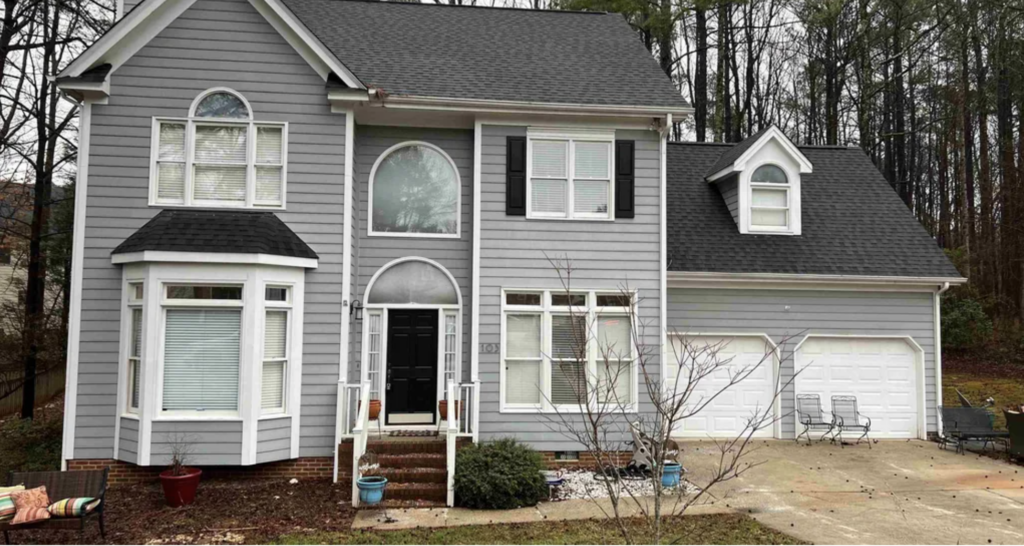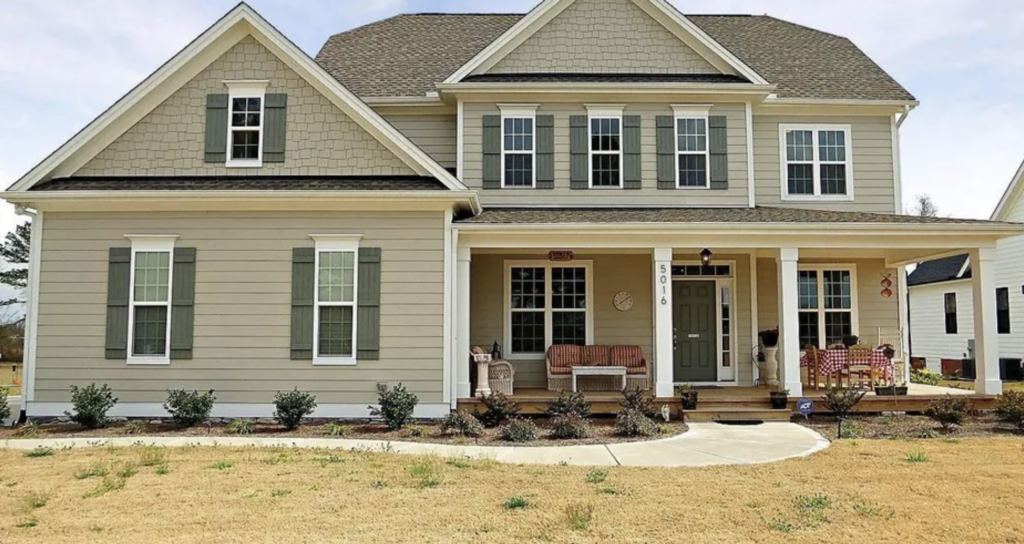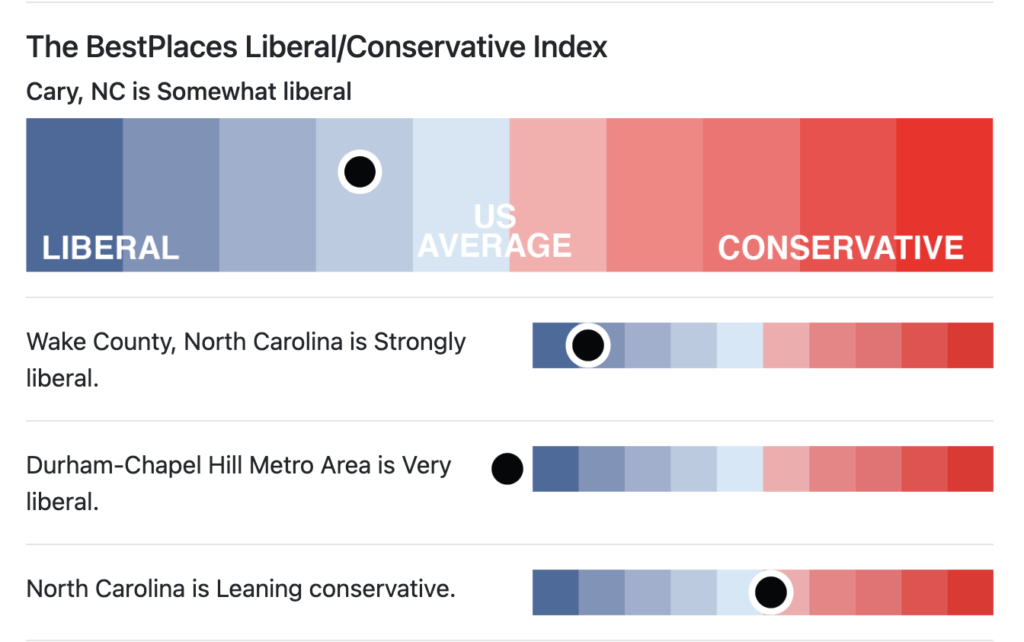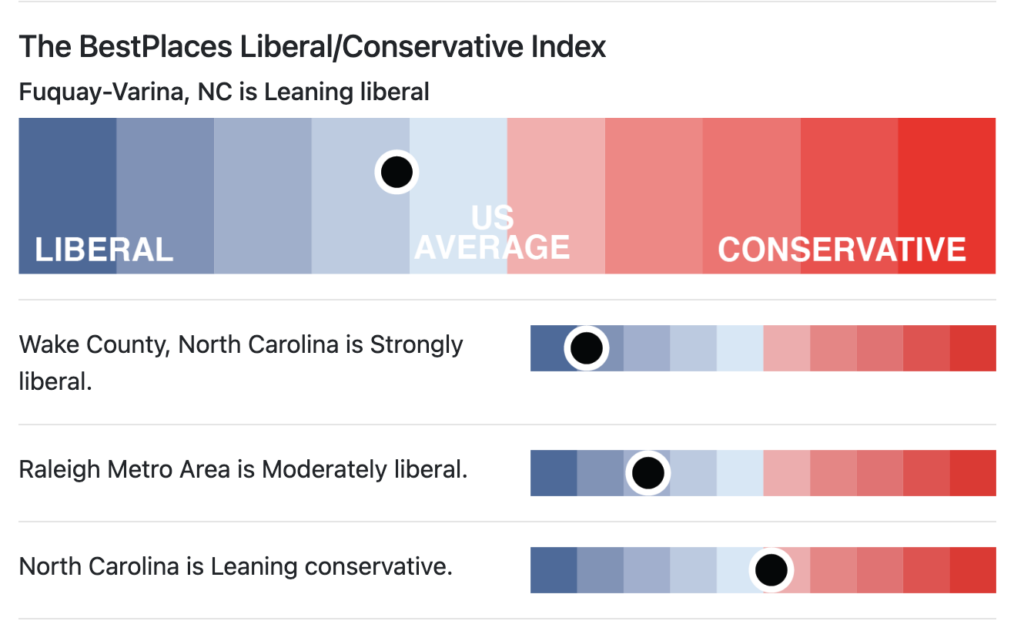For $580,000 you can buy this house in Cary. It has three bedrooms, three baths and 2290 square feet on just under a third of an acre. For that same $580,000 you can buy this house in Fuquay-Varina. It has four bedrooms, four baths, 2924 square feet and the lot twice as big.


They are about a 40 minute drive from each other. Let’s suppose you work from home and commute times aren’t an issue. You can live wherever you want. Why would someone choose the smaller Cary house over the house in Fuquay?
Why chose to spend more?
You might say that the Cary house is the better investment since it’s closer to all the major triangle attractions. But, as we saw last week, home values are increasing across the triangle region in an almost uniform way. That argument might have been good a couple years ago. But it isn’t necessarily the case today.
We’re doing a deep dive into these two towns to try to help you answer whether Fuquay is going to be the next Cary. It is growing. But is it going to become a major RTP suburb with amenities like Cary? Let’s take a look.
Cary is, to many, the geographic envy of the triangle. It is right next to Research Triangle Park and Downtown Raleigh. It’s just a short hop from Cary into Durham whether you’re in east or west cary. It really is hard to beat Cary for commuting convenience. Fuquay is right next to. . . not much.
And that is exactly why Fuquay became what it did… a rural southern town with its own unique culture and economy. But all of that is changing. As the towns and cities of the Triangle expand, Fuquay is becoming something new. We’ll talk about those changes in just a minute, but
First let’s look at the current numbers.
Cary vs Fuquay-Varina: by the numbers
| Cary | Fuquay-Varina | |
| Population | 177,000 | 33,885 |
| Median Income | 104,669 | 79,000 |
| Square Miles | 59.94 | 16.82 |
| Median Home Price | 562,000 | 400,000 |
Cary is obviously a much bigger town. It’s really a city, but it still calls itself a town and has always wanted to keep that small town vibe, even as it grew. However, with the most recent urbanization of downtown Cary, it would be hard to believe that Cary still wants to feel like a small town. It’s simply outgrowing that feel. The median income is higher and the home prices are about 40% higher.
Also, the population is more dense in Cary. Cary has 2950 people per square mile compared to Fuquay’s 2500 people per square mile. That means that generally speaking, there are more homes with larger lots in Fuquay than there are in Cary. What do you get in Cary for those higher home prices besides the convenience?
If you want to see some of our other Cary and Fuquay comparisons, try
- Cary vs Wake Forest
- Cary vs Holly Springs
- Fuquay vs Wake Forest
Why is Cary so Beige?
Cary is one of those hyper-planned communities, and has been ever since the development of RTP back in the 1960s. In fact, one thing that sets Cary apart, and in some circles, brings a lot of criticism, is the way they have very carefully controlled growth over the years. Cary has always been concerned about its image and even back in 1972 passed ordinances to make sure all the signs were pretty. This consistency has sparked conversations about why Cary is so beige.
“Why is Cary so beige?”
“Because Taupe was taken!”
With the Development of Research Triangle Park in 1959, Cary’s population doubled by the 1960’s. This caused a lot of concern that the growth would be out of control so Cary put into place guidelines and ordinances to prevent unchecked growth. They required builders to set aside one acre of greenspace for every 35 housing units constructed.
They created Industrial performance districts to encourage businesses to build within the town limits, which cut down on commuter traffic for jobs outside the city limits. Cary also built the first of their planned unit developments, which it is now known for.
The first one was Kildaire Farms, which now sits in one of the most walkable spots in central Cary and is connected by greenways to shopping, restaurants and coffee shops. Some other popular planned developments in Cary are Savaan, Carpenter Village, Weatherstone, and Highcroft.
Part of the key to Cary’s development was a growing tax base that allowed for so many city amenities to be offered to its residents. As they say, success breeds success. The planning that started in the 60’s is paying huge dividends today.
Fuquay’s Historic Districts
But what about Fuquay? What is the attraction there? So you know, You’ll hear me and others refer to the town as Fuquay, but it’s real name is Fuquay-Varina — a hyphenated name exemplifying the fusion of what used to be 2 small towns, Fuquay and Varina.
Because of that fusion, Fuquay is unique in that it has TWO historic shopping districts both sitting in the center of town less than a mile away from each other. These districts are home to an astonishing number of breweries and coffee shops, cute little boutiques and restaurants. People in Fuquay are fiercely loyal to their town and it’s not unusual to see a competitive rivalry between Fuquayans and Holly Springs residents.
Among the locals, some people will only sheepishly admit they live in Cary, that doesn’t tend to happen in Fuquay.
Fuquay was actually the first place I bought a home in the Triangle 22 years ago. Back then, it was a town of about 8000 people and Cary was about 94 thousand. So the population growth in Fuquay has outpaced Cary’s in relative terms. Fuqay’s population has quadrupled since then and Cary’s has almost doubled.
Growth in Fuquay-Varina
So what has caused the growth in Fuquay? Three things: the growth of the other Western suburbs, the increased accessibility of Fuquay, and prices.
Western Wake Explosion
First, as Cary, Apex, and Holly Springs (the three largest western communities) have grown from bedroom communities to Raleigh and RTP into lively communities of their own, it has made Fuquay more attractive as a bedroom community to these suburbs.
If you live in Fuquay you don’t have to travel very far to get to the amenities that the town might lack. Holly Springs, Fuquay’s neighbor to the north, is developing its own “RTP” focused around the largest growing industry in North Carolina, Biotechnology. This center is bringing companies such as Amgen with a median salary of $119 thousand. In the same way that Cary is 10 minutes from RTP, Fuquay is 10 minutes from Holly Springs’ Friendship Innovation Park.
New Roads
Secondly, the development of I540 has changed the commute pattern for people living in Fuquay who need to drive into RTP. Right now folks in Fuquay can hop onto 540 just north of Holly Springs on highway 55, and as the construction of 540 continues, they’ll soon be able to get onto 540 off of NC 401 on the other side of town. The highways have made Fuquay closer to the rest of the Triangle.
Low Prices
Thirdly, because prices have been historically the lowest in Western Wake County in Fuquay, people who could not afford Cary, Apex or Holly Springs have moved south into Fuquay. This has allowed Fuquay’s tax base to grow to the point that it has developed its own set of community amenities.
What does that growth look like? What does Fuquay now have that it didn’t in the past? Shopping, parks, and greenways.
Greenways in Fuquay
First the greenways. . . When preparing for this video I talked with someone in the planning department in the town of Fuquay and when I mentioned that I was comparing Fuquay to Cary she said something like, “Oh well, Cary is who we all want to be like. They’re the gold standard.”
And the truth is that Cary has been planning and implementing their greenway systems for decades. But what I discovered about Fuquay is that when you really look at what they have, based on population size, they’re not too far off of Cary when it comes to miles of greenway per person.
I sometimes have people from other parts of the country call me and they’re not sure what a greenway is. This is what a greenway looks like. The purpose is to provide paved trails through nature so that people can get their exercise away from the road noise. It’s like a new way to do sidewalks. And in Cary, they have designed them so well, that you can pickup a greenway trail pretty much anywhere in town and walk to a shopping center or restaurant.
This is Fuquay’s master greenway plan. Right now, Fuquay maintains 12 and a half miles of greenway trails and Cary maintains 79 miles of greenway trails. Fuquay maintains 20 parks with over 500 acres of greenspace. The largest two are the Carroll Howard Environmental Park and the Hilltop Needmore Environmental Preserve. Cary maintains over 30 public parks with 2600 acres of greenspace. If you do the math, which, I did it for you, don’t worry, Fuquay actually has more acreage of green space per person than Cary does!
Shopping in Cary
Shopping is important. The kind of shopping available in a town has a REAL impact on property values. Trader Joe’s, Whole Foods, Target, Costco, Starbucks and even the discount store, Aldi, have been shown to have a positive impact on property values increasing for homeowners who live near these stores. Who cares about property values as I know where to get my dark chocolate peanut butter cups (Trader Joes).
But, back in 2000, Cary didn’t have a Trader Joe’s. They did have one of two Wake County Whole Foods stores. There was no Costco. Cary had one Target and one Walmart and neither one was supersized. There wasn’t even a Starbucks. The first Starbucks opened in Cary in 2003.
Today in Cary there is tons of great shopping, including 2 Whole Foods, 2 Aldi’s, 2 Trader Joe’s, a Costco which is actually in Apex but it sits pretty much on the line between Cary and Apex. And I think there’s about 20 Starbucks in Cary. There’s a lot. It’s hard to count.
Shopping in Fuquay
When I first moved to Fuquay in 2000, forget Target, there wasn’t even a Walmart. We had this off brand Walmart type store called Rose’s. Food Lion was the fancy grocery store. And if I wanted to go to Costco, that was like 45 minutes away in North Raleigh. But things have changed a lot in Fuquay since then. On one hand, many boutique and independently owned shops have opened in the downtown areas since then. There is no shortage of beer and coffee in Fuquay. But the bigger retailers have also come into town.
So why is this important? Well if you look back at Cary 20+ years ago, let’s just say in 2000 because that’s the year I moved here so that’s when everything started to get nice. Just kidding. But if you look at the shopping landscape of Cary then, it looks a lot like Fuquay today. Now Fuquay doesn’t yet have a Whole Foods or a Trader Joes. However, they did just get a Costco, which opened this past November and a new Target is coming to Fuquay. It will be located at 2901 Wallace Adcock Blvd in the new Gold Leaf Shopping Center!
So we’re not quite there…but Fuquay is getting pretty close. Also, back when Cary had one of each of these stores, the population was just under 100 thousand people. Fuquay with its smaller population (under 40 thousand), is getting stores much earlier in the game. That’s got to say something about what these companies are anticipating for growth in Fuquay.
Political leanings in Fuquay and Cary
In a poll about Fuquay Varina, people said it is a family friendly, melting pot of middle class people. I would say that’s pretty accurate. In a poll about Cary, residents said is it overwhelmingly friendly, family oriented, cooperative and 2% said it’s progressive. As you can see from this graphic, Cary is somewhat liberal. And Fuquay-Varina also leans liberal but slightly less so than Cary.


Wake County in general leans left compared to many of the surrounding counties. Generally speaking the larger the city, the more liberal it is, but as you can see our cities here in North Carolina are a little more moderate than other larger cities where you might be coming from. This is New York City, Los Angeles and Austin. I tell people all the time, when you move here, it is likely that you will have a conservative neighbor and a liberal neighbor. The state is purple for a reason. I’m just giving information so you can understand the culture here. I’m not saying what is good and what is bad.
Culture of Fuquay and Cary
And speaking of culture, maybe you noticed that one last poll result… Cary residents think their neighbors tend to be cliquey. I live in a neighborhood that allows chickens so I think the standards might be a little different in my neighborhood. One last thing on the demographics. Cary has a higher percentage of residents with graduate degrees.
And speaking of education, Cary schools rank just a little higher than Fuquay’s according to test scores. Fuquay is also one of those towns where the school test scores have been trending up over time. If you haven’t listened to my video about the school system in Wake County, you can watch it here.
The Future of Fuquay-Varina
Where is all this going? Like all triangle towns, Fuquay’s future looks bright. But, will Fuquay look like Cary one day? I’ve got to tell you that the simple fact that they are building condos in downtown Fuquay says a lot about where this little town is headed. For those people looking for a quaint small town that has many of the essential amenities we’ve grown accustomed to, and lower home prices, Fuquay can be very attractive. But will it be another Cary?
There is some good evidence to suggest it might be. And…that it might not be.
From what people tell me, and from community survey studies that have been done in this area, the things that are important to just about everyone in a town is the greenway systems and parks and greenspaces as well as accessibility of shopping. We know that Fuquay is absolutely on the mark right now, keeping pace with Cary for the greenspaces and greenways it offers for its residents based on its current population. Shopping is there and growing.
What we don’t know is will Fuquay continue to grow in the same way? Will it PLAN for the growth that is coming like Cary did with purposeful natural areas created as housing was built?
Planning for Growth
Here are a couple things we do know. the Hilltop Needmore nature preserve was not something that was planned for by the city. It was a defunct golf course that lots of people fought over to determine how it would be developed. And that green area makes up 143 of the 500 acres of greenspace in Fuquay. It’s a big percentage.
These days, any land used for anything other than housing is a political hotbed because we are so short of housing and it’s having such an impact on affordability. But still, we ALL want parks and places to enjoy life near our homes. Fortunately, I think, the Hilltop Preserve did become a park and not townhomes. Fuquay is also doing a wonderful job of planning and creating greenways.
I emailed one of the senior planners at the town of Fuquay and to ask if Fuquay has any greenspace requirements like Cary does. Are more parks are a requirement as the town grows? I haven’t yet heard back from her, but I will definitely add an update in the comments when I have it.
So whether Fuquay is the next Cary or not, is still up for debate. Personally, I think there is a much better candidate for a community developing into the next Cary: Holly Springs.
You can read about Holly Springs here, or check out our blog posts, or videos!

